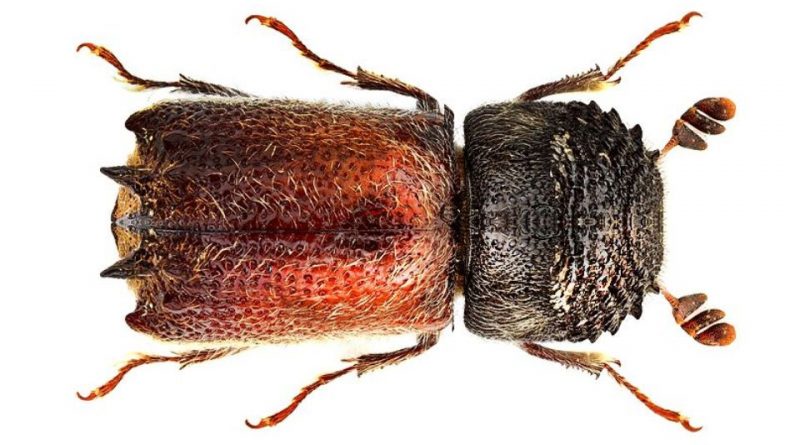Sinoxylon sexdentatum
Sinoxylon sexdentatum
The Bostrich of the vine (Sinoxylon sexdentatum Oliv.) Is a small beetle belonging to the Bostrichidae family.
Systematics –
From a systematic point of view, it belongs to the Eukaryota Domain, Animalia Kingdom, Subgenus Eumetazoa, Phylum Arthropoda, Subphylum Tracheata, Superclass Hexapoda, Class Insecta, Subclass Pterygota, Cohort Endopterygota, Superorder Oligoneoptera, Section Coleopteroidea, Bostrichidae Family, Subfamily Bostrichinae, Tribo Sinoxylinae and then to the genus Sinoxylon and to the S. sexdentatum species.
Geographical Distribution and Habitat –
The Bostrico of the vine is a xylophagous Beetle widespread in the temperate climates of much of the globe and which lives on various host plants; as well as on the Vine it is frequently present on various Fruit Trees (Fico, Pomacee, Ciliegio, Kaki, Susino) and on Olivo, Castagno, Noce, Aceri, Querce, Robinia and others.
Morphology –
The Sinoxylon sexdentatum is a small 4-5 mm beetle that presents in the distal part of the elytra, of brown-blackish color, two spines with a conical, smooth and circular base; this character, along with the pronotum and the head are darker, serves to distinguish the insect from the Sinoxylon perforans, another bark beetle of the vine, which has a very similar appearance as well as being slightly larger (5-7 mm).
The larvae of this Bostrich have a light color, with a curved shape and the terminal part of the abdomen swells.
Attitude and biological cycle –
The Bostrico della Vite (similar to Sinoxylon perforans) winters at the adult stage in small cells obtained in the branches, or in other host plants contiguous to the vineyards, using for this purpose also dead wood or in phase of deterioration.
In the second half of April the adults come out and carry themselves on the dead branches of at least two years or on those remaining of the pruning on which the females perform a ring excavation (reproduction tunnel) around a knot or semicircular when the diameter of the branch exceeds 2 cm. on average, each female excavates 3-6 reproduction galleries, at different heights, on the same branch or on nearby ones. After fertilization, the female starts almost immediately ovide in an average of 150 to 180 eggs and in number of 20-65 for each reproduction gallery.
After 7-17 incubation rounds, the larvae are born starting from the third decade of May and until the end of June.
As soon as they are born, the larvae begin to dig 10-15 cm long tunnels parallel to the shoot axis. The larvae reach maturity within a month, from the end of June to that of July, to then pupate and give the adults after 7-10 days. These flicker from mid-July to August with maximum attendance in the last decade of July. From August to September the adult individuals dig longitudinal nutrition tunnels, 2-4 cm long, in the medullary area of the branches in the process of lignification and towards the first days of October they form burrows within which then they will overwinter.
Thus the Bostriches make only one generation a year.
Ecological Role –
The Bostrico of the vine is a xylophagous insect that carries out a large part of its biological cycle, even in the larval state by digging tunnels in the wood.
The damage is caused above all by adults who, towards the end of summer-autumn, dig nutrition galleries at the base or on the nodes of the vintage shoots. The attacks cause a reduction of the lymphatic flow compromising the production. The damage caused to the branches for the following vintage is very serious: in fact, these are easily broken during bending operations. The attack is to be feared in some forms of breeding and after years with strong winter frosts that dry up numerous branches or undermine the vitality of the plants.
The galleries, although more rarely, can also be made in the stems. Furthermore, these tunnels are easy way for the entry of fungal pathogens that cause far more serious diseases such as: bait, apoplexia, etc.
The fight against this bark beetle (together with Sinoxylon perforans) is based on the removal of dried and infested shoots and on the removal and destruction of the remains of the pruning.
It is essential in this intervention to eliminate the old branches left to support the new ones.
Moreover it is very useful to place, hanging from the poles or the threads of the vineyard, from mid-April to mid-May, fascine bait of branches in order to attract the females that are ready to lay eggs; subsequently, these bundles must be removed and burned in mid-June, before the adults come out.
The struggle is therefore mainly agronomic, always keeping the vineyard boundary and eliminating the plants and vegetation in the deteriorating phase where the insect tends to lay eggs.
Guido Bissanti
Sources
– Wikipedia, the free encyclopedia.
– Russo G., 1976. Agrarian Entomology. Special Part. Liguori Editore, Naples.
– Tremblay E., 1997. Applied entomology. Liguori Editore, Naples.

